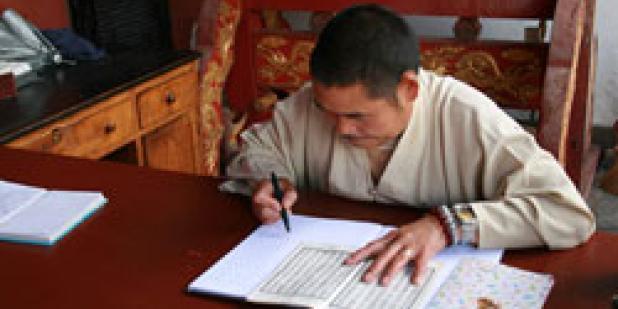Join us for a free one-day workshop for educators at the Japanese American National Museum, hosted by the USC U.S.-China Institute and the National Consortium for Teaching about Asia. This workshop will include a guided tour of the beloved exhibition Common Ground: The Heart of Community, slated to close permanently in January 2025. Following the tour, learn strategies for engaging students in the primary source artifacts, images, and documents found in JANM’s vast collection and discover classroom-ready resources to support teaching and learning about the Japanese American experience.
Commentary-writing in Chinese Buddhism
Imre Hamar (University of Virginia) will explore the significance of commentaries is holy scriptures and ancient written texts.
Where

In several major cultures of the world, commentaries make up a considerable proportion of the full body of written texts. Holy scriptures are often hazy and ambiguous, or even completely incomprehensible, without additional explanations. To understand them in the right way is, therefore, both an important task and a serious challenge for the literati of all times. In Chinese Buddhist literature, the significance of commentaries is well illustrated by the fact that in the Taish? edition they make up eleven and a half volumes, as opposed to the four and a half volumes of essays expounding the teachings of schools. The formal and essential criteria of commentary-writing formulated gradually, with commentary as a genre attaining its final form by Tang times. This is the form that became the model to be followed by later generations. In this lecture, Professor Hamar will show the process of how commentary-writing developed from the early period and discuss the main features of the full-fledged commentary.
Imre Hamar received his Ph.D. from the Hungarian Academy of Science in 1997 and earned his habilitation in 2004 with the completion of his study titled "Manifestation of Buddha." He has published many books and articles in Hungarian and English, most recently "A Religious Leader in the Tang: Chengguan?s Biography" (2002) and "A kínai buddhizmus története" (History of Chinese Buddhism) (2004). In addition to his appointment as Professor of Chinese Studies at Eötvös Loránd University (ELTE) in Budapest, Dr. Hamar is also the director of ELTE's Institute of East Asian Studies. He is a Fulbright Scholar at the University of Virginia for the 2008-09 academic year.
Featured Articles
Please join us for the Grad Mixer! Hosted by USC Annenberg Office of International Affairs, Enjoy food, drink and conversation with fellow students across USC Annenberg. Graduate students from any field are welcome to join, so it is a great opportunity to meet fellow students with IR/foreign policy-related research topics and interests.
RSVP link: https://forms.gle/1zer188RE9dCS6Ho6
Events
Hosted by USC Annenberg Office of International Affairs, enjoy food, drink and conversation with fellow international students.
Join us for an in-person conversation on Thursday, November 7th at 4pm with author David M. Lampton as he discusses his new book, Living U.S.-China Relations: From Cold War to Cold War. The book examines the history of U.S.-China relations across eight U.S. presidential administrations.




